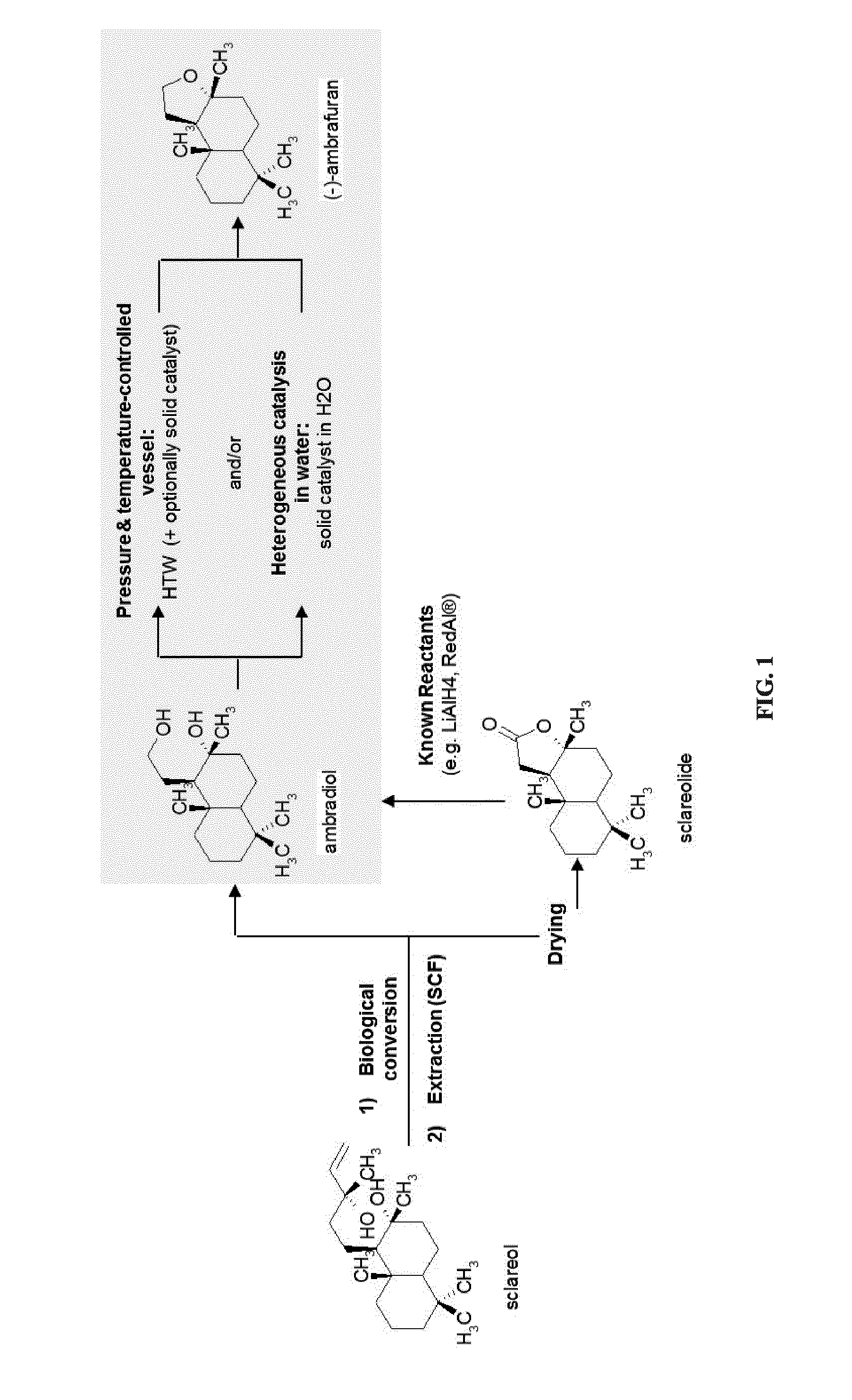Process for the cyclodehydration of diols and use thereof for the manufacturing of ambrafuran and other cycloether derivatives
- Summary
- Abstract
- Description
- Claims
- Application Information
AI Technical Summary
Benefits of technology
Problems solved by technology
Method used
Image
Examples
example 1
[0312]
[0313]Ambradiol was converted into (−)-ambrafuran (scheme 5) in presence of HTW using CO2 for pressure control with prior water degassing.
[0314]12 ml distilled water was mixed with 100 mg ambradiol in a 300 ml pressure reactor in stainless steel. After initial degassing using CO2, 1.5 bars of CO2 pressure was applied and temperature was raised to 150° C., which caused the system pressure to reach 7 bars. System parameters were maintained and mixture was stirred at 500 rpm for 3.5 hours. At the end of the experiment, products were extracted from the mixture and dried in rotavapor. Chromatograph and mass spectra (FIGS. 9 and 10) were compared to that of standard (−)ambrafuran (FIGS. 7 and 8) and standard ambradiol (FIGS. 5 and 6).
[0315]This experiment produced a conversion yield of 92.5% with 100% selectivity to (−) ambrafuran. No isomer of (−)ambrafuran was detected.
example 2
[0316]Ambradiol was converted into (−)-ambrafuran (scheme 5) in presence of HTW using CO2 for pressure control with no prior water degassing.
[0317]15 ml distilled water was mixed with 100 mg ambradiol in a 300 ml pressure reactor in stainless steel. 1 bar of CO2 pressure was applied and temperature was raised to 140° C., which caused the system pressure to reach 5.2 bars. System parameters were maintained and mixture was stirred at 500 rpm for 2 hours. At the end of the experiment, products were extracted from the mixture and dried in rotavapor. Chromatograph and mass spectra (FIGS. 11 and 12) were compared to that of standard (−)ambrafuran (FIGS. 7 and 8) and standard ambradiol (FIGS. 5 and 6).
[0318]This experiment produced a conversion yield of 91.3% with 87.45% selectivity to (−) ambrafuran while the remaining 12.55% consisted of oxidation products of ambradiol, primarily aldehyde and carboxylic acid-ambradiol derivatives that were confirmed using NMR. No isomer of (−)ambrafuran ...
example 3
[0320]In order to test the rehydration and isomerization of (−)ambrafuran in HTW, (−) ambrafuran was subjected to HTW (scheme 5) using CO2 for pressure control with no prior water degassing.
[0321]12 ml distilled water was mixed with 100 mg (−)ambrafuran in a 300 ml pressure reactor in stainless steel. 1.2 bars of CO2 pressure was applied and temperature was raised to 150° C., which caused the system pressure to reach 6.5 bars. System parameters were maintained and mixture was stirred at 500 rpm for 2 hours. At the end of the experiment, products were extracted from the mixture and dried in rotavapor. Chromatograph and mass spectra (FIGS. 15 and 16) were compared to that of standard (−)ambrafuran (FIGS. 7 and 8) and standard ambradiol (FIGS. 5 and 6).
[0322]No conversion was observed.
PUM
| Property | Measurement | Unit |
|---|---|---|
| Biological properties | aaaaa | aaaaa |
Abstract
Description
Claims
Application Information
 Login to View More
Login to View More - R&D
- Intellectual Property
- Life Sciences
- Materials
- Tech Scout
- Unparalleled Data Quality
- Higher Quality Content
- 60% Fewer Hallucinations
Browse by: Latest US Patents, China's latest patents, Technical Efficacy Thesaurus, Application Domain, Technology Topic, Popular Technical Reports.
© 2025 PatSnap. All rights reserved.Legal|Privacy policy|Modern Slavery Act Transparency Statement|Sitemap|About US| Contact US: help@patsnap.com



